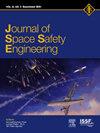A framework for compatible-by-design orbit coordination in LEO
IF 1.7
Q3 ENGINEERING, AEROSPACE
引用次数: 0
Abstract
As more and more operators propose and begin to deploy large constellations, finite orbital volume in Low Earth Orbit (LEO) is becoming increasingly congested. Intelligently organizing and coordinating large constellations to efficiently make use of LEO and avoid hazardous conjunctions between on-station satellites can significantly reduce risk with minimal burden to satellite operators. This work describes the intrinsic capacity framework for understanding geometric constraints to compatible orbital design and orbit loading. This framework provides a way to calculate efficiency of orbital use, remaining unconsumed orbital volume, and efficacy of capacity-expanding measures. The paper describes various potential policy objectives associated with orbit loading. It explores ways to achieve them with different technical architectures.
基于设计的兼容轨道协调框架
随着越来越多的运营商提出并开始部署大型星座,低地球轨道(LEO)有限的轨道体积正变得越来越拥挤。智能组织和协调大型星座,有效利用低轨道,避免站内卫星之间的危险交会,可以显著降低风险,使卫星运营商负担最小。这项工作描述了理解兼容轨道设计和轨道载荷的几何约束的内在能力框架。该框架提供了一种计算轨道使用效率、剩余未消耗轨道体积和扩大能力措施效力的方法。本文描述了与轨道载荷相关的各种潜在政策目标。它探索了用不同的技术架构实现它们的方法。
本文章由计算机程序翻译,如有差异,请以英文原文为准。
求助全文
约1分钟内获得全文
求助全文
来源期刊

Journal of Space Safety Engineering
Engineering-Safety, Risk, Reliability and Quality
CiteScore
2.50
自引率
0.00%
发文量
80
 求助内容:
求助内容: 应助结果提醒方式:
应助结果提醒方式:


